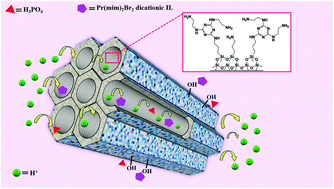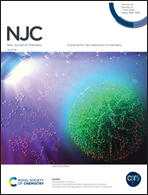High temperature composite membranes based on polybenzimidazole and dendrimer amine functionalized SBA-15 mesoporous silica for fuel cells†
Abstract
In this study SBA-15, melamine-based dendrimer amine functionalized SBA-15 mesoporous silica (MDA-SBA-15), and the 1,3-di(3-methylimidazolium) propane dibromide dicationic ionic liquid (pr(mim)2Br2) were used in order to improve the proton conductivity, and thermal and mechanical stability of phosphoric acid (PA) doped polybenzimidazole (PBI)-based composite membranes for application in high-temperature proton exchange membrane (PEM) fuel cells. The effect of the porous structure of the mesoporous silica on the performance of the PA doped PBI-based membrane containing pr(mim)2Br2 was investigated under high temperature. The experimental results implied that MDA-SBA-15 containing the groups of NH2, and melamine-based dendrimer amines (MDA) on the internal wall of its pores provides special sites for further interaction with pr(mim)2Br2, PBI, and PA in the composite membranes. The presence of NH2 and MDA groups plays an important role in creating several pathways for proton exchange in the composite membranes. The PA-doped PBI-based composite membranes containing 4.5% w/w pr(mim)2Br2, and 1.5% w/w MDA-SBA-15 exhibit a high proton conductivity of 0.22 S cm−1 at 180 °C under dry conditions. The current density of 1.18 A cm−2, and power density of 0.60 W cm−2 at 0.50 V and 180 °C confirm the enhanced potential of the PA doped PBI-based composite membranes for application in high-temperature PEM fuel cells.



 Please wait while we load your content...
Please wait while we load your content...